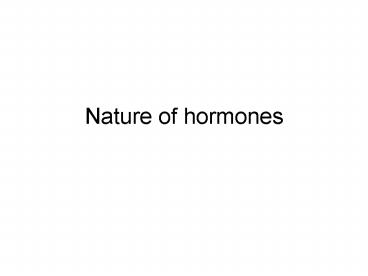Nature of hormones PowerPoint PPT Presentation
Title: Nature of hormones
1
Nature of hormones
2
What is a hormone?
- Hormone
- Greek I excite or I arouse
- Classical definition
- Chemical messenger released by one type of cells
and carried in the bloodstream to act on specific
target cells - Modern definition
- Includes factors produced and used locally
without entering the blood stream
3
- Endocrine factors
- Released and carried in the blood
- Classical hormones
- Autocrine factors
- Released and used by the same cells
- Paracrine factors
- Affect function of neighboring cells without
entering the blood stream - Interstitial fluid
4
GnRH
Hypothalamus
FSH
LH
Estradiol
Pituitary gland
Ovary
5
Granulosa cells
Basement membrane
Antrum
Oocyte
Theca externa
Theca interna
6
Granulosa cells (GC)
Theca cells (TC)
Basement membrane
7
General characteristics of hormones
- Very low in concentrations
- Ppb (ng/ml) or ppt (pg/ml)
- Very specific receptor
- One hormone, one receptor
8
Chemical nature of hormones
- Classes
- Lipids
- Steroids
- Eicosanoids
- Proteins
- Short polypeptides
- Large proteins
- Chemical modification through glycosylation
- Amino acid derivatives
9
Steroid hormones
- Derivative of cholesterol
- Large molecule
- Hydrocarbon ring
- Highly hydrophobic
- Source
- Diet
- De Novo synthesis
- Found in cell membrane
10
Cholesterol and its derivatives
- Derivatives
- Vitamin D
- Bile acid
- Lipid digestion
- Steroid hormones
- Sex steroids
- Adrenal steroild
- All cholesterol derivatives contain sterol ring
11
Steroid hormones
- Origins
- Adrenal
- Mineralocorticoids
- Affect mineral homeostasis
- Glucocorticoids
- Affect glucose metabolism and immune function
- Gonads (testis and ovaries)
- Estrogens
- Progestins/progestagens
- Androgens
12
www.endotext.org/male/male1/figures1/figure13.gif
13
Eicosanoids
- Metabolites of 12-C fatty acid
- Arachidonic acid
- Prostaglandins
- Produced by numerous tissues and organs
- Originally isolated from prostate gland secretion
- Inflammatory reaction
- Reproduction
- Thromboxanes, leukotriens, and prostacyclins
14
(No Transcript)
15
Protein hormones
- Short chain of amino acids
- Neurohormones
- GnRH (10)
- Oxytocin (9)
- TRH (3)
16
(No Transcript)
17
Protein hormones
- Large polypeptides
- Linear chain
- Subunits
- Linked by disulfide bridge(s)
- 3-D structure
- Critical for interaction with receptor
18
(No Transcript)
19
- Chemical modification
- Glycosylation
- Common in gonadotropins (LH, FSH, hCG, eCG)
- Sulfation
- Acetylation
20
(No Transcript)
21
Protein hormones
- Isoform and variants
- Amino acid substitution
- Gene duplication
22
Amino acid metabolites
- Tyrosine metabolites
- Thyroid hormones
- Thyroxine
- Triiodothyronine
- Adrenal medulla
- Epinephrine
- Norepinephrine
- Dopamine
- Often used as neurotransmitters
23
(No Transcript)
24
Endocrine glands
- Composition
- Parenchyma (mass of cells)
- Secretory cells
- Blood vessels
- Highly vasucualized
- No ducts
- Permanent or transient
- Pituitary, adrenal, pancreas etc
- Ovarian follicle and corpus luteum
25
Cells that produce hormone
- Specialized secretory cells
- Usually one type of cells produce one hormone
- Neurons
- Hypothalamus
- Posterior pituitary
- Adrenal medulla
26
Hormone synthesis
- Protein hormones
- Transcription
- Translation
- Physical/chemical modification
- Cleaving of long amino acid chain
(preprohormones) to generate small peptide
hormones (GnRH, oxytocin, TRH) - Interaction and linking of subunits
- 3-D structure
27
- Metabolism
- Cholesterol (steroids)
- Smooth ER
- Mitochondria
- Tyrosine
- Thyroid follicular cells (thyroid hormones)
- Thyroglobulin
- Adrenal medulla
- Nerve terminals
28
Control of synthesis and secretion
- Neural inputs
- Brain
- Hypothalamus
- Hormonal stimulation/inhibition
- Releasing factors/hormones
- Inhibitory factors
- Feedback system
- Metabolic status
- Stress
- Blood concentrations of substances
- Ca
- Glucose
- Water
29
Hormones in circulation
- Peptides and some protein hormones (i.e. insulin)
- Very short half-life
- Degraded by proteolytic enzymes
- Large protein hormones
- Longer half-life
30
- Steroids
- Water-insoluble
- Bound to binding globulins (SHBG or CBG) and
albumin - Some steroids exist as free form
- Short half-life
- Thyroid hormones
- Thyroxine-binding globulin (TBG)
- Transthyretin

